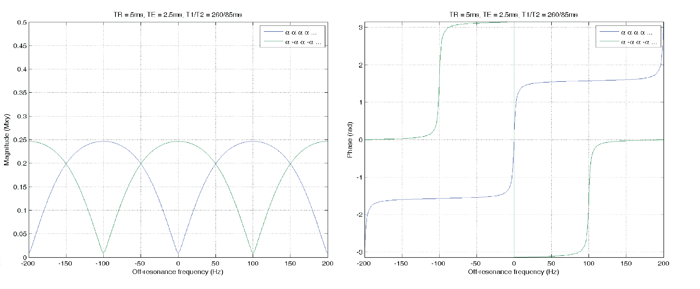Variation of excitation pulse train
In this part, we show some examples of the evolution of magnetization at different excitation pulse train.
3.1 a, a, a, a, vs a, -a, a, -a,
The movies show that the dynamics of the magnetization for the two cases are different. The signal-off-resonance characteristics (both magnitude and phase of the signal) depend on the excitation pulse train. Note that the curves for a, -a, a, -a, are shifted by 1/(2TR) in the off-resonance frequency axis from the curves of a, a, a, a, . All simulated parameters are the same as in 1.1.

3.2 a, -a, a, -a, vs a/2, -a, a, -a, a,
The results show the influence of an a/2 preparation pulse which is applied only once at the beginning. The magnetization approaches to the steady state smoothly in the presence of a/2 preparation pulse. Without the preparation pulse, the pulse train produces signal fluctuations which can cause severe image artifacts. The simulations were done using the following parameters: T1 = 200 ms, T2 = 50 ms, TR = 10 ms, TE = TR/2, flip angle a = 60° and only on-resonance frequency.
References
[1] Carr HY. Steady-state free precession in nuclear magnetic resonance. Phys. Rev. (1958) 112:1693-1701.
[2] Scheffler K and Lehnhardt S. Principles and applications of balanced SSFP techniques. Eur. Radiol. (2003) 13:2409-2418.
| By Myung-Ho In / Chaiya Luengviriya |






